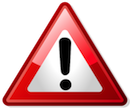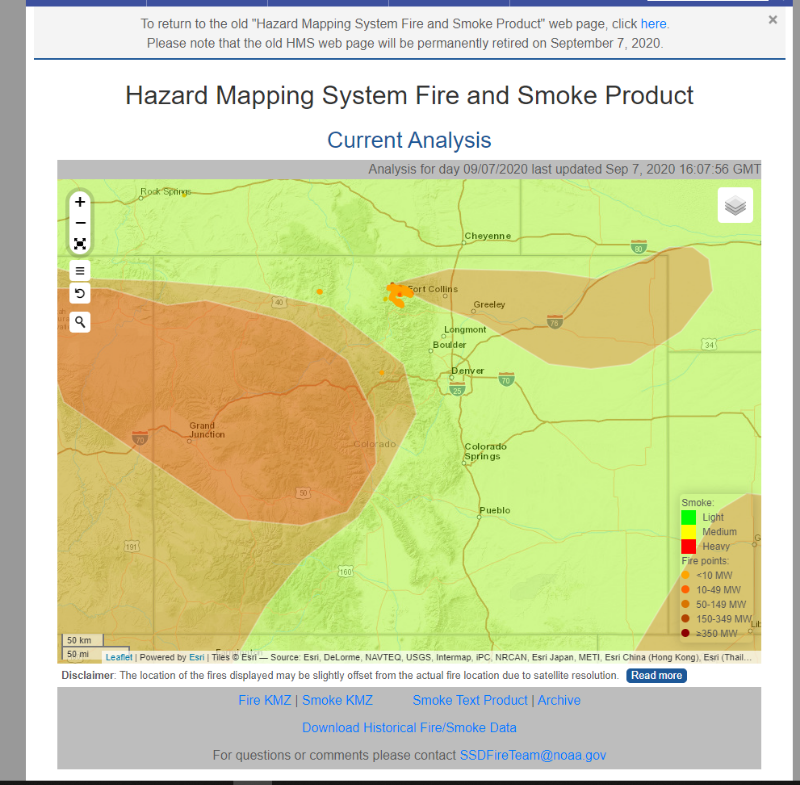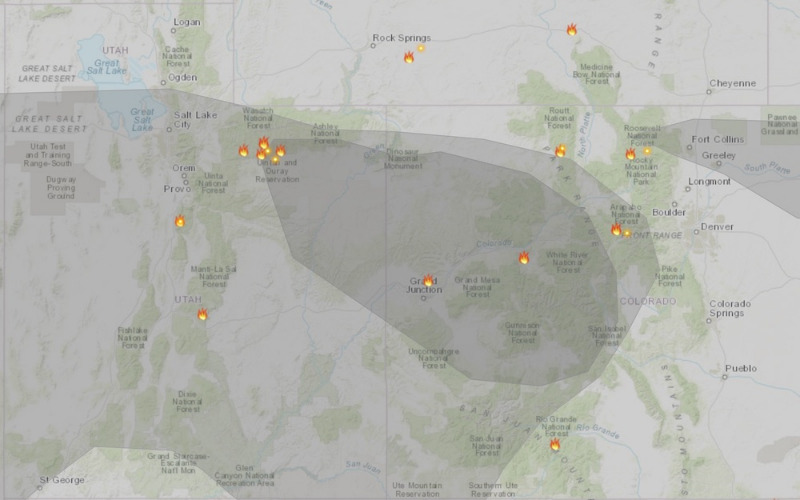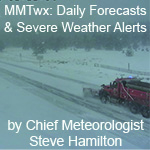- Posts: 9549
- Thank you received: 219
- Forum
- Life Up the Hill
- Scanner & Emergency Info, Weather Forecasts
- Front Range Air Quality Forecast & Colorado Smoke Outlook September 7
Front Range Air Quality Forecast & Colorado Smoke Outlook September 7
- MountainTownAlerts
-
 Topic Author
Topic Author
- Mountain Legend
-

Less
More
07 Sep 2020 12:45 #1
by MountainTownAlerts
www.ospo.noaa.gov/Products/land/hms.html
fire.airnow.gov/
The Colorado Department of Public Health and Environment has issued an ACTION DAY ALERT at 4PM on Sunday, September 6, 2020 for the Front Range Urban Corridor from Douglas County north to Larimer and Weld counties, including the Denver-Boulder area, Fort Collins and Greeley.
Smoke from the Cameron Peak fire in western Larimer County is expected to result in concentrations of fine particulate matter that are Unhealthy for Sensitive Groups, with some areas reaching the higher Unhealthy category. Concentrations of fine particulates in the Unhealthy category are most likely for localized areas directly downwind of the Cameron Peak wildfire, including Ft. Collins and Longmont. Fine particulate concentrations in the Unhealthy for Sensitive Groups category are likely for the rest of the northern Colorado Front Range region, including locations from the Denver Metro area northward to Fort Collins and Greeley.
This Particulates Action Day Alert will remain in effect until at least 4 p.m. Monday, September 7, 2020.
For statewide conditions, forecasts and advisories, visit:
www.colorado.gov/airquality/colorado_summary.aspx
At 11AM (MST), Monday, 9/7/2020 the highest AQI value was 169 for Particulate less than 2.5 micrometers which indicates Unhealthy air quality. Increased aggravation of heart or lung disease and premature mortality in people with cardiopulmonary disease and older adults; increased respiratory effects in general population. People with heart or lung disease, older adults, and children should avoid prolonged or heavy exertion; everyone else should reduce prolonged or heavy exertion.
The Colorado Department of Public Health and Environment and the Regional Air Quality Council's Summer 2020 Ozone Action Day Alert Program has concluded. The winter High Pollution Advisory Program begins on November 1. Air Quality Action Days or advisories for ozone for other pollutants, however, will be issued as needed at any time during the year and reported on this web page.
The Air Pollution Control Division's Winter 2020/2021 High Pollution Advisory Program will begin November 1. Thank you for your interest in and support for efforts to improve air quality for the citizens of the Denver- metro area.
Front Range Air Quality Forecast & Colorado Smoke Outlook
FRONT RANGE AIR QUALITY FORECAST:
Monday, September 7, 2020, 7:00 AM MDT
Ozone concentrations are expected to be in the Good to Moderate range on Monday. Moderate concentrations of ozone are anticipated throughout the Front Range region during the afternoon and early evening hours.
Fine Particulate Matter concentrations are expected to be in the Moderate to Unhealthy range on Monday. Concentrations of fine particulates in the Unhealthy category are most likely for areas near the Cameron Peak wildfire, and for some localized areas of the northern Front Range downwind of the fire from Longmont northward to Ft. Collins. In these areas, people with heart or lung disease, older adults, and children should avoid prolonged or heavy exertion; everyone else should reduce prolonged or heavy exertion. Concentrations of fine particulates in the Unhealthy for Sensitive Groups category are likely for the rest of the northern Colorado Front Range region, including locations from the Denver Metro area northward to Fort Collins and Greeley. In these areas people with heart or lung disease, older adults, and children should reduce prolonged or heavy exertion.
Carbon Monoxide concentrations are expected to be in the Good category on Monday.
Nitrogen Dioxide concentrations are expected to be in the Good category on Monday.
Visibility on Monday is expected to be Poor.
Public Health Recommendations: If smoke is thick or becomes thick in your neighborhood you may want to remain indoors. This is especially true for those with heart disease, respiratory illnesses, the very young, and the elderly. Consider limiting outdoor activity when moderate to heavy smoke is present. Consider relocating temporarily if smoke is present indoors and is making you ill. If visibility is less than 5 miles in smoke in your neighborhood, smoke has reached levels that are unhealthy.
Outlook: Areas of moderate to heavy smoke have been observed across western Colorado due to transported smoke from wildfires in northeastern Utah. Gusty winds and dry conditions at the Utah fires will result in high fire activity on Monday and continued periods of moderate to heavy smoke across western Colorado through at least Monday evening. Rain and snow moving into the area late Monday night will result in a significant decrease in smoke concentrations in northwestern Colorado by early Tuesday morning, with slower improvement expected for southwestern Colorado.
The 12,1232 acre Williams Fork wildfire is located in Grand County, approximately 15 miles south of Granby. Winds near the fire on Monday will be out of the west to northwest, and is expected to be breezy to gusty at times. This will transport any smoke to areas to the east or southeast of the fire. This may bring hazy skies and periods of light to moderate smoke to areas downwind of the fire, including Winter Park, Fraser, and Empire. Heavy snow will develop over the fire late Monday night which will significantly decrease smoke concentrations for the area.
The Middle Fork wildfire is located in Routt County approximately 12 miles northeast of Steamboat Springs. The heaviest smoke Monday morning will be confined to the Mad Creek drainage within the Medicine Bow-Routt National Forest. Gusty westerly winds are expected at the fire Monday afternoon which will send smoke downwind to locations east of the fire, mainly impacting the Mt. Zirkel Wilderness Area, however light to moderate concentrations of smoke will be possible further downwind in Coalmont and Walden. Heavy snow late Monday night will significantly decrease smoke concentrations throughout the area.
Periods of smoke from out-of-state wildfires will continue to be transported into Colorado on Monday. This will cause hazy skies and light to moderate concentrations of smoke to be present across northern and central Colorado on Monday. In areas where Moderate concentrations of smoke are experienced, unusually sensitive people should consider reducing prolonged or heavy exertion on Monday. Heavy precipitation will an approaching cold front late Monday night into Tuesday morning will significantly improve air quality statewide.
Light to moderate smoke is also possible near prescribed fires and small wildfires around the state.
What if there is a wildfire or smoke in your area?
The focus of the Colorado Smoke Outlook is on large fires (e.g., greater than 100 acres in size). Nevertheless, smoke from smaller fires, prescribed fires, and/or smoke from new fires not yet known to CDPHE air quality meteorologists may cause locally heavy smoke. If there is smoke in your neighborhood, see the public health recommendations below.
Public health recommendations for areas affected by smoke:
If smoke is thick or becomes thick in your neighborhood you may want to remain indoors. This is especially true for those with heart disease, respiratory illnesses, the very young, and the elderly. Consider limiting outdoor activity when moderate to heavy smoke is present. Consider relocating temporarily if smoke is present indoors and is making you ill. IF VISIBILITY IS LESS THAN 5 MILES IN SMOKE IN YOUR NEIGHBORHOOD, SMOKE HAS REACHED LEVELS THAT ARE UNHEALTHY.
WHAT IS AN ACTION DAY?: An Action Day for fine particulate matter, carbon monoxide, ozone or other pollutants indicates that either current air quality is unhealthy or conditions are expected to worsen later in the day or on the next day. Action Days for air pollutants generally indicate that air quality will be in either the Unhealthy or Unhealthy-for-Sensitive-Groups categories according to the Air Quality Index. Action Days always convey overarching public health recommendations, and, according to season, trigger a variety of mandatory and voluntary pollution prevention measures. For example, during the summer open burning is prohibited when an Action Day for ozone and/or fine particulates is in effect. During the winter, residential burning restrictions are in effect when an Action Day for Visibility is in effect.
For a detailed description of both the AIR QUALITY INDEX and the VISIBILITY STANDARD INDEX please visit www.colorado.gov/airquality/brochure.aspx
COLORADO OPEN BURN FORECAST: For those with permits for open burning, that is the burning of waste materials or vegetation outside, check the following webpage to find out if open burning is allowed today. Keep in mind that open burning is prohibited when an Action Day is in effect:
www.colorado.gov/airquality/burn_forecast.aspx
FOR CURRENT FRONT RANGE ACTION DAYS/ADVISORIES:
www.colorado.gov/airquality/advisory.aspx
FOR CURRENT AIR QUALITY CONDITIONS STATEWIDE:
www.colorado.gov/airquality/air_quality.aspx
SOCIAL MEDIA:
www.facebook.com/cdphe.apcd
twitter.com/cdpheapcd
AIR QUALITY NOTIFICATIONS:
www.colorado.gov/airquality/request_alerts.aspx (CDPHE automated e-mail alerts)
www.enviroflash.info/signup.cfm (CDPHE forecasts via automated e-mails from the EPA)
Front Range Air Quality Forecast & Colorado Smoke Outlook September 7 was created by MountainTownAlerts
www.ospo.noaa.gov/Products/land/hms.html
fire.airnow.gov/
The Colorado Department of Public Health and Environment has issued an ACTION DAY ALERT at 4PM on Sunday, September 6, 2020 for the Front Range Urban Corridor from Douglas County north to Larimer and Weld counties, including the Denver-Boulder area, Fort Collins and Greeley.
Smoke from the Cameron Peak fire in western Larimer County is expected to result in concentrations of fine particulate matter that are Unhealthy for Sensitive Groups, with some areas reaching the higher Unhealthy category. Concentrations of fine particulates in the Unhealthy category are most likely for localized areas directly downwind of the Cameron Peak wildfire, including Ft. Collins and Longmont. Fine particulate concentrations in the Unhealthy for Sensitive Groups category are likely for the rest of the northern Colorado Front Range region, including locations from the Denver Metro area northward to Fort Collins and Greeley.
This Particulates Action Day Alert will remain in effect until at least 4 p.m. Monday, September 7, 2020.
For statewide conditions, forecasts and advisories, visit:
www.colorado.gov/airquality/colorado_summary.aspx
At 11AM (MST), Monday, 9/7/2020 the highest AQI value was 169 for Particulate less than 2.5 micrometers which indicates Unhealthy air quality. Increased aggravation of heart or lung disease and premature mortality in people with cardiopulmonary disease and older adults; increased respiratory effects in general population. People with heart or lung disease, older adults, and children should avoid prolonged or heavy exertion; everyone else should reduce prolonged or heavy exertion.
The Colorado Department of Public Health and Environment and the Regional Air Quality Council's Summer 2020 Ozone Action Day Alert Program has concluded. The winter High Pollution Advisory Program begins on November 1. Air Quality Action Days or advisories for ozone for other pollutants, however, will be issued as needed at any time during the year and reported on this web page.
The Air Pollution Control Division's Winter 2020/2021 High Pollution Advisory Program will begin November 1. Thank you for your interest in and support for efforts to improve air quality for the citizens of the Denver- metro area.
Front Range Air Quality Forecast & Colorado Smoke Outlook
FRONT RANGE AIR QUALITY FORECAST:
Monday, September 7, 2020, 7:00 AM MDT
Ozone concentrations are expected to be in the Good to Moderate range on Monday. Moderate concentrations of ozone are anticipated throughout the Front Range region during the afternoon and early evening hours.
Fine Particulate Matter concentrations are expected to be in the Moderate to Unhealthy range on Monday. Concentrations of fine particulates in the Unhealthy category are most likely for areas near the Cameron Peak wildfire, and for some localized areas of the northern Front Range downwind of the fire from Longmont northward to Ft. Collins. In these areas, people with heart or lung disease, older adults, and children should avoid prolonged or heavy exertion; everyone else should reduce prolonged or heavy exertion. Concentrations of fine particulates in the Unhealthy for Sensitive Groups category are likely for the rest of the northern Colorado Front Range region, including locations from the Denver Metro area northward to Fort Collins and Greeley. In these areas people with heart or lung disease, older adults, and children should reduce prolonged or heavy exertion.
Carbon Monoxide concentrations are expected to be in the Good category on Monday.
Nitrogen Dioxide concentrations are expected to be in the Good category on Monday.
Visibility on Monday is expected to be Poor.
Public Health Recommendations: If smoke is thick or becomes thick in your neighborhood you may want to remain indoors. This is especially true for those with heart disease, respiratory illnesses, the very young, and the elderly. Consider limiting outdoor activity when moderate to heavy smoke is present. Consider relocating temporarily if smoke is present indoors and is making you ill. If visibility is less than 5 miles in smoke in your neighborhood, smoke has reached levels that are unhealthy.
Outlook: Areas of moderate to heavy smoke have been observed across western Colorado due to transported smoke from wildfires in northeastern Utah. Gusty winds and dry conditions at the Utah fires will result in high fire activity on Monday and continued periods of moderate to heavy smoke across western Colorado through at least Monday evening. Rain and snow moving into the area late Monday night will result in a significant decrease in smoke concentrations in northwestern Colorado by early Tuesday morning, with slower improvement expected for southwestern Colorado.
The 12,1232 acre Williams Fork wildfire is located in Grand County, approximately 15 miles south of Granby. Winds near the fire on Monday will be out of the west to northwest, and is expected to be breezy to gusty at times. This will transport any smoke to areas to the east or southeast of the fire. This may bring hazy skies and periods of light to moderate smoke to areas downwind of the fire, including Winter Park, Fraser, and Empire. Heavy snow will develop over the fire late Monday night which will significantly decrease smoke concentrations for the area.
The Middle Fork wildfire is located in Routt County approximately 12 miles northeast of Steamboat Springs. The heaviest smoke Monday morning will be confined to the Mad Creek drainage within the Medicine Bow-Routt National Forest. Gusty westerly winds are expected at the fire Monday afternoon which will send smoke downwind to locations east of the fire, mainly impacting the Mt. Zirkel Wilderness Area, however light to moderate concentrations of smoke will be possible further downwind in Coalmont and Walden. Heavy snow late Monday night will significantly decrease smoke concentrations throughout the area.
Periods of smoke from out-of-state wildfires will continue to be transported into Colorado on Monday. This will cause hazy skies and light to moderate concentrations of smoke to be present across northern and central Colorado on Monday. In areas where Moderate concentrations of smoke are experienced, unusually sensitive people should consider reducing prolonged or heavy exertion on Monday. Heavy precipitation will an approaching cold front late Monday night into Tuesday morning will significantly improve air quality statewide.
Light to moderate smoke is also possible near prescribed fires and small wildfires around the state.
What if there is a wildfire or smoke in your area?
The focus of the Colorado Smoke Outlook is on large fires (e.g., greater than 100 acres in size). Nevertheless, smoke from smaller fires, prescribed fires, and/or smoke from new fires not yet known to CDPHE air quality meteorologists may cause locally heavy smoke. If there is smoke in your neighborhood, see the public health recommendations below.
Public health recommendations for areas affected by smoke:
If smoke is thick or becomes thick in your neighborhood you may want to remain indoors. This is especially true for those with heart disease, respiratory illnesses, the very young, and the elderly. Consider limiting outdoor activity when moderate to heavy smoke is present. Consider relocating temporarily if smoke is present indoors and is making you ill. IF VISIBILITY IS LESS THAN 5 MILES IN SMOKE IN YOUR NEIGHBORHOOD, SMOKE HAS REACHED LEVELS THAT ARE UNHEALTHY.
WHAT IS AN ACTION DAY?: An Action Day for fine particulate matter, carbon monoxide, ozone or other pollutants indicates that either current air quality is unhealthy or conditions are expected to worsen later in the day or on the next day. Action Days for air pollutants generally indicate that air quality will be in either the Unhealthy or Unhealthy-for-Sensitive-Groups categories according to the Air Quality Index. Action Days always convey overarching public health recommendations, and, according to season, trigger a variety of mandatory and voluntary pollution prevention measures. For example, during the summer open burning is prohibited when an Action Day for ozone and/or fine particulates is in effect. During the winter, residential burning restrictions are in effect when an Action Day for Visibility is in effect.
For a detailed description of both the AIR QUALITY INDEX and the VISIBILITY STANDARD INDEX please visit www.colorado.gov/airquality/brochure.aspx
COLORADO OPEN BURN FORECAST: For those with permits for open burning, that is the burning of waste materials or vegetation outside, check the following webpage to find out if open burning is allowed today. Keep in mind that open burning is prohibited when an Action Day is in effect:
www.colorado.gov/airquality/burn_forecast.aspx
FOR CURRENT FRONT RANGE ACTION DAYS/ADVISORIES:
www.colorado.gov/airquality/advisory.aspx
FOR CURRENT AIR QUALITY CONDITIONS STATEWIDE:
www.colorado.gov/airquality/air_quality.aspx
SOCIAL MEDIA:
www.facebook.com/cdphe.apcd
twitter.com/cdpheapcd
AIR QUALITY NOTIFICATIONS:
www.colorado.gov/airquality/request_alerts.aspx (CDPHE automated e-mail alerts)
www.enviroflash.info/signup.cfm (CDPHE forecasts via automated e-mails from the EPA)
Please Log in or Create an account to join the conversation.
- Forum
- Life Up the Hill
- Scanner & Emergency Info, Weather Forecasts
- Front Range Air Quality Forecast & Colorado Smoke Outlook September 7
Time to create page: 0.149 seconds








